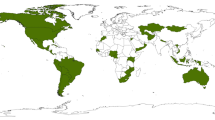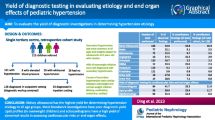Abstract
Background
Congenital anomalies of the kidney and urinary tract (CAKUT) are the primary cause of pediatric chronic kidney disease. Maternal body mass index (BMI) before pregnancy, pregestational diabetic mellitus (DM), and gestational diabetic mellitus (GDM) are potential modifiable risk factors for CAKUT in offspring.
Methods
In this case control study, 4619 neonates were enrolled during 2012–2020 from Kaohsiung Veterans General Hospital in Taiwan. Maternal risk factors before and during pregnancy were compared in children with and without CAKUT. The yearly incidence of CAKUT in offspring and maternal overweight were recorded.
Results
In total, 73 (1.6%) cases of CAKUT in offspring were identified. Maternal overweight before pregnancy (BMI ≥ 24 kg/m2) was an independent risk factor for CAKUT in offspring. No associations of pregestational DM and GDM with CAKUT in offspring were observed. The incidence rates of CAKUT and maternal obesity have increased in the past 10 years.
Conclusions
Maternal obesity before pregnancy is associated with CAKUT in offspring and should be addressed to ensure better outcomes.
Graphical abstract

A higher resolution version of the Graphical abstract is available as Supplementary information

Similar content being viewed by others
Data availability
The datasets generated during and/or analyzed during the current study are available from the corresponding author on reasonable request.
Code availability
Not applicable.
References
Song R, Yosypiv IV (2011) Genetics of congenital anomalies of the kidney and urinary tract. Pediatr Nephrol 26:353–364
Ardissino G, Daccò V, Testa S, Bonaudo R, Claris-Appiani A, Taioli E, Marra G, Edefonti A, Sereni F (2003) Epidemiology of chronic renal failure in children: data from the ItalKid project. Pediatrics 111:e382–e387
Chiou YY, Lin CY, Chen MJ, Chiou YH, Wang YF, Wang HH, Tain YL, Chou HH (2016) Etiology and pediatric chronic kidney disease progression: Taiwan Pediatric Renal Collaborative Study. J Formos Med Assoc 115:752–763
North American Pediatric Renal Trials and Collaborative Studies (NAPRTCS) (2011) NAPRTCS 2011 Annual Dialysis Report. https://naprtcs.org/system/files/2011_Annual_Dialysis_Report.pdf. Accessed 15 Sept 2022
Sanna-Cherchi S, Ravani P, Corbani V, Parodi S, Haupt R, Piaggio G, Innocenti ML, Somenzi D, Trivelli A, Caridi G, Izzi C, Scolari F, Mattioli G, Allegri L, Ghiggeri GM (2009) Renal outcome in patients with congenital anomalies of the kidney and urinary tract. Kidney Int 76:528–533
Nef S, Neuhaus TJ, Spartà G, Weitz M, Buder K, Wisser J, Gobet R, Willi U, Laube GF (2016) Outcome after prenatal diagnosis of congenital anomalies of the kidney and urinary tract. Eur J Pediatr 175:667–676
Soares CM, Diniz JS, Lima EM, Silva JM, Oliveira GR, Canhestro MR, Colosimo EA, Simoes e Silva AC, Oliveira EA (2008) Clinical outcome of children with chronic kidney disease in a pre-dialysis interdisciplinary program. Pediatr Nephrol 23:2039–2046
Kagan M, Pleniceanu O, Vivante A (2022) The genetic basis of congenital anomalies of the kidney and urinary tract. Pediatr Nephrol 37:2231–2243
Welham SJ, Riley PR, Wade A, Hubank M, Woolf AS (2005) Maternal diet programs embryonic kidney gene expression. Physiol Genomics 22:48–56
Dart AB, Ruth CA, Sellers EA, Au W, Dean HJ (2015) Maternal diabetes mellitus and congenital anomalies of the kidney and urinary tract (CAKUT) in the child. Am J Kidney Dis 65:684–691
Tain YL, Luh H, Lin CY, Hsu CN (2016) Incidence and risks of congenital anomalies of kidney and urinary tract in newborns: a population-based case-control study in Taiwan. Medicine 95:e2659
Dyck RF, Karunanayake C, Pahwa P, Stang M, Erickson RL, Osgood ND (2021) Congenital anomalies of the kidney and urinary tract (CAKUT): an emerging relationship with pregestational diabetes mellitus among first nations and non-first nations people in Saskatchewan—results from the DIP: ORRIIGENSS Project. Can J Diabetes 45:346-354.e341
Hsu CW, Yamamoto KT, Henry RK, De Roos AJ, Flynn JT (2014) Prenatal risk factors for childhood CKD. J Am Soc Nephrol 25:2105–2111
Macumber I, Schwartz S, Leca N (2017) Maternal obesity is associated with congenital anomalies of the kidney and urinary tract in offspring. Pediatr Nephrol 32:635–642
Obesity: preventing and managing the global epidemic (2000) Report of a WHO consultation. World Health Organ Tech Rep Ser 894:i-xii, 1–253
Razak F, Anand SS, Shannon H, Vuksan V, Davis B, Jacobs R, Teo KK, McQueen M, Yusuf S (2007) Defining obesity cut points in a multiethnic population. Circulation 115:2111–2118
Health Promotion Administration, Ministry of Health and Welfare (2018) Taiwan’s Obesity Prevention and Management Strategy. https://health99.hpa.gov.tw/storage/pdf/materials/21937.pdf. Accessed 15 Sept 2022
Institute of Medicine (US) and National Research Council (US) Committee to Reexamine IOM Pregnancy Weight Guidelines (2009) The National Academies Collection: Reports funded by National Institutes of Health. In: Rasmussen KM, Yaktine AL (eds) Weight gain during pregnancy: reexamining the guidelines. National Academies Press, Washington, DC
Shoelson SE, Herrero L, Naaz A (2007) Obesity, inflammation, and insulin resistance. Gastroenterology 132:2169–2180
Catalano PM, Hauguel-De Mouzon S (2011) Is it time to revisit the Pedersen hypothesis in the face of the obesity epidemic? Am J Obstet Gynecol 204:479–487
Kelly AC, Powell TL, Jansson T (2020) Placental function in maternal obesity. Clin Sci (Lond) 134:961–984
WHO Expert Consultation (2004) Appropriate body-mass index for Asian populations and its implications for policy and intervention strategies. Lancet 363:157–163
Caleyachetty R, Barber TM, Mohammed NI, Cappuccio FP, Hardy R, Mathur R, Banerjee A, Gill P (2021) Ethnicity-specific BMI cutoffs for obesity based on type 2 diabetes risk in England: a population-based cohort study. Lancet Diabetes Endocrinol 9:419–426
Li R, Chase M, Jung SK, Smith PJ, Loeken MR (2005) Hypoxic stress in diabetic pregnancy contributes to impaired embryo gene expression and defective development by inducing oxidative stress. Am J Physiol Endocrinol Metab 289:E591-599
Jang H, Kim TW, Yoon S, Choi SY, Kang TW, Kim SY, Kwon YW, Cho EJ, Youn HD (2012) O-GlcNAc regulates pluripotency and reprogramming by directly acting on core components of the pluripotency network. Cell Stem Cell 11:62–74
Langley-Evans SC, Pearce J, Ellis S (2022) Overweight, obesity and excessive weight gain in pregnancy as risk factors for adverse pregnancy outcomes: a narrative review. J Hum Nutr Diet 35:250–264
Deputy NP, Dub B, Sharma AJ (2018) Prevalence and trends in prepregnancy normal weight - 48 states, New York City, and District of Columbia, 2011–2015. Morb Mortal Wkly Rep 66:1402–1407
Lee SI, Azcoaga-Lorenzo A, Agrawal U, Kennedy JI, Fagbamigbe AF, Hope H, Subramanian A, Anand A, Taylor B, Nelson-Piercy C, Damase-Michel C, Yau C, Crowe F, Santorelli G, Eastwood KA, Vowles Z, Loane M, Moss N, Brocklehurst P, Plachcinski R, Thangaratinam S, Black M, O’Reilly D, Abel KM, Brophy S, Nirantharakumar K, McCowan C (2022) Epidemiology of pre-existing multimorbidity in pregnant women in the UK in 2018: a population-based cross-sectional study. BMC Pregnancy Childbirth 22:120
Chen CN, Yu HC, Chou AK (2020) Association between maternal pre-pregnancy body mass index and breastfeeding duration in Taiwan: a population-based cohort study. Nutrients 12:2361
Chen HM, Wu CF, Hsieh CJ, Kuo FC, Sun CW, Wang SL, Chen ML, Wu MT (2022) Relationship of maternal body weight and gestational diabetes mellitus with large-for-gestational-age babies at birth in Taiwan: The TMICS cohort. Taiwan J Obstet Gynecol 61:234–242
Acknowledgements
The authors express their gratitude to the Department of Medical Education and Research and Research Center of Medical Informatics in Kaohsiung Veterans General Hospital for assistance with respect to inquiries and data processing.
Funding
This study had no funding.
Author information
Authors and Affiliations
Contributions
NWF proposed the idea of the project, and conducted the literature review. All the authors contributed to the study design. NWF, CHY, and YSH collected and analyzed data. NWF wrote the draft manuscript. JSC and YHC critically reviewed the manuscript and were involved in writing the final manuscript. All authors read and approved the final manuscript. NWF and YHC take responsibility for the article.
Corresponding author
Ethics declarations
Ethics approval
The study was approved by KSVGH institutional review board (KSVGH20-CT-16).
Conflict of interest
The authors declare no conflict of interest.
Additional information
Publisher's note
Springer Nature remains neutral with regard to jurisdictional claims in published maps and institutional affiliations.
Supplementary information
Below is the link to the electronic supplementary material.
Rights and permissions
Springer Nature or its licensor (e.g. a society or other partner) holds exclusive rights to this article under a publishing agreement with the author(s) or other rightsholder(s); author self-archiving of the accepted manuscript version of this article is solely governed by the terms of such publishing agreement and applicable law.
About this article
Cite this article
Fang, NW., Huang, Ys., Yin, CH. et al. Maternal risk factors in offspring with congenital anomalies of the kidney and urinary tract in Asian women. Pediatr Nephrol 38, 3065–3070 (2023). https://doi.org/10.1007/s00467-023-05954-6
Received:
Revised:
Accepted:
Published:
Issue Date:
DOI: https://doi.org/10.1007/s00467-023-05954-6




